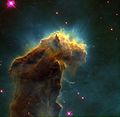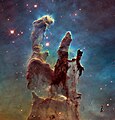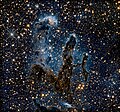Eagle Nebula
arcmins[citation needed] | |
|---|---|
| Constellation | Serpens |
| Physical characteristics | |
| Radius | 70×55 (cluster 15)[citation needed] ly |
| Absolute magnitude (V) | -8.21[citation needed] |
| Notable features | 1–2 million years old[citation needed] |
| Designations | Messier 16, NGC 6611,[1] Sharpless 49, RCW 165, Cr 375, Gum 83, Star Queen Nebula |
The Eagle Nebula (catalogued as Messier 16 or M16, and as NGC 6611, and also known as the Star Queen Nebula) is a young
Characteristics

The Eagle Nebula is part of a diffuse emission nebula, or H II region, which is catalogued as IC 4703. This region of active current star formation is about 5700 light-years distant. A spire of gas that can be seen coming off the nebula in the northeastern part is approximately 9.5 light-years or about 90 trillion kilometers long.[6]
The cluster associated with the nebula has approximately 8100 stars, which are mostly concentrated in a gap in the molecular cloud to the north-west of the Pillars.[7] The brightest star (HD 168076) has an
The descriptive names reflect impressions of the shape of the central pillar rising from the southeast into the central luminous area. The name "Star Queen Nebula" was introduced by
"Pillars of Creation" region
(animation; 0:15; 11 November 2022)
Images produced by Jeff Hester and Paul Scowen using the
X-ray images from the Chandra observatory compared with Hubble's "Pillars" image have shown that X-ray sources (from young stars) do not coincide with the pillars, but rather randomly dot the nebula.[13] Any protostars in the pillars' EGGs are not yet hot enough to emit X-rays.[citation needed]
Evidence from the Spitzer Space Telescope originally suggested that the pillars in M16 may be threatened by a "past supernova". Hot gas observed by Spitzer in 2007 suggested they were already – likely – being disturbed by a supernova that exploded 8,000 to 9,000 years ago. Due to the distance the main blast of light would have reached Earth for a brief time 1,000 to 2,000 years ago. A more slowly moving, theorized, shock wave would have taken a few thousand years to move through the nebula and would have blown away the delicate pillars. However, in 2014 the pillars were imaged a second time by Hubble, in both visible light and infrared light. The images being 20 years later provided a new, detailed account of the rate of evaporation occurring within the pillars. No supernova is evidenced within them, and it is estimated in some form they still exist – and will appear for at least 100,000 more years.
Gallery
-
Locator of well-known areas in the nebula
-
The "Pillars of Creation" within the Eagle Nebula
-
Detail of the HST image
-
A higher-resolution HST image of the "Pillars of Creation" was taken 20 years after the original.
-
The pillars are more transparent in thisESO infraredview.
-
HST infrared view
-
The "Black Pillar" spire on the eastern perimeter is about 9.5 light-years long.
-
Open cluster within the Eagle Nebula
-
Northwestern part of the region, well away from the centre
-
Starless version edit of the M16 Eagle Nebula, showing also the Pillars of Creation. Image total exposure of 15 hours, taken from a Bortle 7 in Nicosia, Cyprus
-
The Eagle Nebula captured in the SHO Hubble palette with 3nm filters
-
Eagle Nebula ("Pillars" in circle; WISE; 11 November 2022
See also
- List of Messier objects
- NGC 1193
References
- ^ a b c "M 16". SIMBAD. Centre de données astronomiques de Strasbourg. Retrieved 2006-11-16.
- ^
Kuhn, Michael A.; Hillenbrand, Lynne A.; Sills, Alison; Feigelson, Eric D.; Getman, Konstantin V. (2018). "Kinematics in Young Star Clusters and Associations with Gaia DR2". The Astrophysical Journal. 870 (1): 32. S2CID 119328315.
- ^ "Messier 16". SEDS Messier Catalog. Archived from the original on 13 May 2022. Retrieved 28 April 2022.
- ^ Martin MacPhee (8 July 2014). "The awesome beauty of M16, the Eagle Nebula". EarthSky. Retrieved 25 September 2015.
- ^ ISBN 978-0-486-23673-5.
- ^ "The Eagle has risen: Stellar spire in the Eagle Nebula". 25 April 2005. Retrieved 9 May 2021.
- ^
Kuhn, M. A.; et al. (2015). "The Spatial Structure of Young Stellar Clusters. II. Total Young Stellar Populations". S2CID 119309858.
- S2CID 14271184.
- doi:10.1086/116774.
- ^ "Spitzer Captures Cosmic "Mountains Of Creation"". Spacedaily.com. Retrieved 2012-04-01.
- ^ Nemiroff, R.; Bonnell, J., eds. (16 September 2008). "W5: Pillars of Star Creation". Astronomy Picture of the Day. NASA.
- ^ Nemiroff, R.; Bonnell, J., eds. (20 November 2011). "W5: Pillars of Star Formation". Astronomy Picture of the Day. NASA.
- ^ "Chandra, Photo Album, The Eagle Nebula (M16), 15 Feb 07". Chandra.harvard.edu. Retrieved 2012-04-01.
- ^ Overbye, Dennis (19 October 2022). "Webb Telescope Captures New View of 'Pillars of Creation' - The NASA space observatory's infrared eye finds out what's going on within the cloudy cosmic nursery". The New York Times. Retrieved 21 October 2022.
External links
- The Eagle Nebula on
- The Eagle's EGGs – ESOPhoto Release
- ESO: An Eagle of Cosmic Proportions incl. Photos & Animations
- ESO: VST Captures Three-In-One incl. Photos & Animations
- M16 @ Seds.org, SEDS Messier page on M16
- Spacetelescope.org, Hubble telescope images on M16
- Darkatmospheres.com, Eagle Nebula M16 (wide)
- NASA.gov, APOD February 8, 2009 picture Eagle Nebula
- Szymanek, Nik; Lawrence, Pete; Crowther, Paul; Merrifield, Michael. "M16 – Eagle Nebula". Deep Sky Videos. Brady Haran.
- Eagle Nebula (Messier 16) at Constellation Guide












![The "Pillars of Creation" captured by JWST NIRCam[14]](http://upload.wikimedia.org/wikipedia/commons/thumb/b/b4/Pillars_of_Creation_%28NIRCam_Image%29.png/69px-Pillars_of_Creation_%28NIRCam_Image%29.png)

